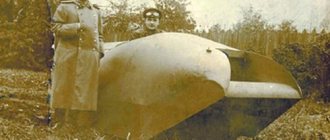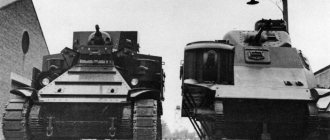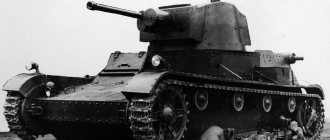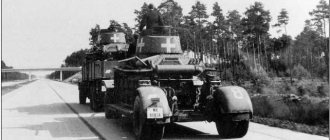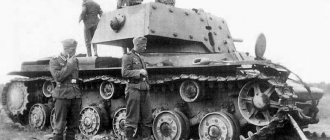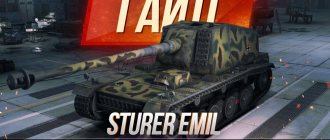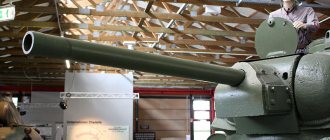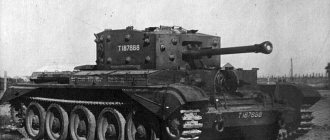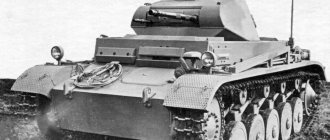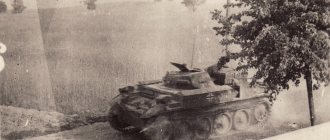Camouflage of Red Army tanks, western direction
(June 22 - December 31, 1941) Before the war, after much experimentation, a camouflage system was finally developed for the armored vehicles of the Red Army, consisting of yellow-green (7K) and dark brown (6K) spots applied over green ( 4BO) background. But such a camouflage scheme never became widespread.
The system of protective painting, camouflage and tactical designations used by the armored units of the Red Army in this theater of operations was quite uniform, closest to the requirements of the regulations and underwent its most minor changes over the entire period described above.
This situation was due to a number of factors. First of all, this is the fact that the main combat operations on the Soviet-German front (until mid-spring 1942) took place precisely in the western direction. Consequently, new formations and products from tank factories were supplied primarily to this theater of operations to make up for the high “natural” loss of materiel. Secondly, in conditions of intense fighting and rapid replacement of materiel, the crews did not have much motivation to create additional camouflage schemes and complex tactical designations. Thirdly, the main green paint of the Soviet 4BO armored formations was developed specifically for the color landscape of the mixed deciduous-coniferous forests of Belarus and Central Russia, so green-painted tanks and armored vehicles did not require additional camouflage in the summer. The winter camouflage system, developed by military specialists of the Red Army, was also most suitable for landscape changes caused by the climatic conditions of winter in Central Russia.
Formations of the 6th microorganism of the Red Army are advancing to the state border of the USSR. On one of the BT-7s, the tactical number “22” is visible on the rear side of the turret. Western Front, June 22, 1941 (AVL).
By June 22, 1942, as part of the Western Special Military District, which was deployed to the Western Front, there were 6 mechanized corps of the Red Army (6, 11, 13, 14, 17, 20 microns) of which 4 (6, 11, 13, 14 microns) ) were quite combat-ready, and 2 (17, 20 mk) had only a combat training tank fleet, the composition of which varied within 100 vehicles for each mechanized corps. During June 22-23, 1941, most of the above-described formations were forced to engage in battle with German troops, extremely shortening the period of mobilization measures.
A BT-7A artillery support tank abandoned due to technical damage. The red star of national identification is visible on the tower. Western Front, 14th Mechanized Corps, June 1941 (RGAKFD).
Broken Soviet T-26 tanks of various modifications (model 1933 and 1939) from the 6th Mechanized Corps of the Red Army. One of them has the old markings from 1932-1938, and the tactical number “1” is visible on the T-26 from 1939. the photographs were taken in 1944, after the liberation of Belarus by Soviet troops. In the background, T-34/85 tanks passing to the west are visible, the crews of which salute the heroes of 1941 (AVL).
The tanks of the ZapOVO mechanized corps were painted green 4BO. A system of tactical designations was not provided, however, armored vehicles of older releases, which previously consisted of tank and cavalry units stationed on the territory of Belarus, until 1939 had tactical designations of the 1932 model of solid and intermittent stripes, colored squares and numbers. There were red stars on the sides of the turrets of some vehicles.
T-26 tanks, model 1939, from the 18th Tank Division of the 7th Mechanized Corps of the Red Army. The combat vehicles have a three-color zebra camouflage of light green and brown stripes applied on a gray-green background. Western Front, early July 1941 (AVL).
The most prepared for battle among the mechanized corps of the Western Front was 6 MK. He entered battle on the afternoon of June 23, 1941, carrying out the task of preventing the flanking of the Soviet group on the territory of Belarus. Some of the tanks, primarily command tanks, still received tactical numbers. They were painted in white on the rear of the turret or, in some cases, on the sides of the turret or turret box.
The remaining tank formations and units (except for the above mechanized corps, armored units were in the 6th and 36th cavalry divisions of the 6th Cavalry Corps as part of tank regiments with 64 BT tanks each, as well as in a separate tank company (BT-tanks 7, armored vehicles BA-10) of the 1st separate motorized rifle regiment of the NKVD, which was transferred to Belarus from Lithuania on June 23, 1941. - Ed.) were painted green 4B0 and most did not have tactical designations.
By the end of June 1941, the overwhelming majority of the tanks of the mechanized corps of the Western Front were lost in battles and encirclement, in which formations of the 3rd and 10th armies of the Red Army found themselves trapped in Minsk. The front, where the 4th and 13th armies remained, essentially had to be rebuilt from scratch. In order to deploy the 19th, 20th, 21st and 22nd armies arriving at the front, it was necessary to delay the German offensive for at least a few days. This task was entrusted to the 5th and 7th mechanized corps of the Red Army, which arrived at the front in early July 1941.
The 7th Mechanized Corps of the Moscow Military District was one of the most powerful formations of the Red Army. By the beginning of the war, it contained 715 tanks and armored vehicles of various brands in two tank (14, 18 td) and the famous motorized (1st Moscow Proletarian Motorized Rifle Division) divisions. But only serviceable, combat-ready vehicles were transferred to the front, and even taking into account the material arriving directly from the factories, the number of tanks participating in the battles did not exceed 500.
On July 6, 1941, the 14th Tank Division had 192 tanks: 176 BT-7 and 16 flamethrower vehicles based on the T-26.
On July 6, 1941, the 18th Tank Division had 236 tanks: 178 T-26, 47 flamethrower tanks based on the T-26 and 11 BT-7.
Broken BT-7 tanks of various modifications from the 14th Mechanized Corps of the Red Army. The red stars on some tank turrets are clearly visible. Belarus, July 1941 (AVL).
The most common color scheme for Soviet tanks at the beginning of the war. The color is grass green 4BO without any tactical markings. The picture shows a KB shot down in the Zelva area (33 km from Slonim). Belarus, 6th Mechanized Corps of the Red Army, July 1941 (AVL).
The 1st Moscow Proletarian Motorized Rifle Division, an elite formation of the Red Army that demonstrated the power of ground forces at parades in Moscow, had up to 100 tanks, of which about 50 BT-7M and 40 T-34 and KV.
Before being sent to the front, the equipment of the 7th Mechanized Corps was painted in three-color camouflage according to the requirements of the instructions. And apparently they were in a hurry: they gave the order to apply camouflage, provided paints, but did not familiarize the tank crews with standard paint schemes, relying on the crews’ abilities. Therefore, depending on the specific units, the tanks had different camouflage patterns: from striped in 3 colors (green-yellow-brown or, in some cases, brown, light and dark green) to spotted vehicles. There were no tactical markings on the 7 MK armored vehicles.
It should be noted that the material part of the tank regiments of the 7th Mechanized Corps was replenished daily from July 6 with new KB and T-34 tanks arriving from factories and repair bases, which were immediately distributed among the units. These tanks were painted with green 4B0 paint; no camouflage was applied to them.
The 5th mechanized corps, which arrived in the western part of the USSR from the Trans-Baikal Military District, was originally intended for the Southwestern Front (the 109th motorized division of the 5th mechanized corps even managed to fight on it. - Author's note), however, due to the complex situation in Belarus, 5 MK was transferred to the Western Front. There were 924 tanks in three tank and one motorized divisions of the corps (in addition to the 2 regular tank divisions of the 5th Mk, the 57th separate Red Banner Tank Division of the ZabVO was operationally subordinated. - Author's note). This vehicle was painted 4BO green, without the use of complex camouflage. The 109th Motorized Division used large tactical white three-digit numbers that were painted on the sides of the turrets of BT-5 tanks.
The brave crew of the T-34/76 tank (from left to right): turret gunner K.L. Levin, radio operator F.F. Ishkov, driver mechanic A. Proshin and platoon commander Lieutenant I. Chuvashev. They destroyed 5 enemy tanks and 2 anti-tank guns. There are 2 white vertical marks visible on the tower. Western Front, 107th Tank Division, July 1941 (AVL).
5 and 7 MK entered the battle on July 6, trying to defeat the enemy group in the area of the settlements of Lepel-Senno. The 1st Proletarian Moscow Motorized Rifle Division conducted combat operations independently in the Orsha region. Despite the fact that our tankers fought bravely and even advanced a little to the west, the counterattack of the mechanized corps was not developed. Under continuous attacks from enemy aircraft, suffering heavy losses, the mechanized corps covered the retreat of the combined arms armies to new lines of defense.
From the second ten days of July to mid-September 1941, the Battle of Smolensk unfolded on the Western Front of the defense of the Soviet armies (July 10 - September 10, 1941 - Author's note). Fearing new encirclements, the Red Army command persistently sought to seize the initiative in the theater of operations. However, counterattacks required fresh armored formations, which were formed in the rear on the basis of the 25th Mechanized Corps from the Kharkov Military District, the 23rd Mechanized Corps from the Oryol Military District and the 27th Mechanized Corps from the Central Asian Military District. The departments of these mechanized corps were disbanded after arriving at the front, and on the basis of the tank divisions that were the most equipped with equipment (in 23,25,27 MK there were only old, worn-out tanks from the combat training fleet. - Ed.) new armored formations were formed: the 104th (out of 9 td 27 mk), 105th (out of 53 td 27 mk), 110th (out of 51 td 23 mk), 50th (25 mk), 55th (25 mk). 101st and 102nd tank divisions, which also formed on the basis of the 52nd and 56th tank divisions of the 26th mechanized corps of the North Caucasus District, 107th tank division, renamed from the 69th motorized division, 108th The tank division (formerly the 59th Panzer Division of the Far Eastern District) appeared on the Western Front as a separate division in mid-July 1941.
The 109th Separate Tank Division appeared on the Western Front a little later - on August 30, 1941. The typical separate tank division itself, according to state number 010/44 dated July 6, 1941, had 215 tanks, of which 20 KB, 42 T-34, 153 T-26 and BT.
T-34/76 of the 101st Tank Division of the Red Army, supported by 45-mm anti-tank guns (model 1932), are preparing to attack the enemy. The tactical number “11” is visible on the tank’s turret. Western Front, July 1941 (RGAKFD).
In reality, the composition of the newly formed formations fluctuated between 180-220 tanks and armored vehicles for each armored division. They contained tanks of both old and new brands. For example, in the 109 TD on August 30, 1941 there were 7 KB, 20T-34, 82T-26, 13ХТ-130, 22 BT-2-5-7, 10 T-40, 10 BA-10 and 13 light armored vehicles. Most of the equipment was painted with green 4BO paint; occasionally tactical numbers (for example, “11” or “365”) or inscriptions and slogans were applied to tanks or armored vehicles with white paint: “Beat the fascists!”, “Beat the fascist reptile!”, “Victory will be for us!" etc. There were also currently unsolved tactical systems in the form of two vertical rectangles (maybe the 2nd battalion), painted on each side of the tank turret with white paint...
In August 1941, due to heavy losses, some tank formations began to be transferred to motorized rifle divisions. The tank regiment of such a division, according to the reduced staff on July 6, 1941, had 93 tanks: 7 KB, 22 T-34, 64 BT and T-26. The 1st Moscow Proletarian Division, 101st and 107th Tank Divisions became motorized rifle divisions. The 82nd motorized rifle division of the pre-war formation, which consisted not of a tank regiment, but of a tank battalion, arrived in the western direction in September 1941.
Also at the end of August 1941, the first separate tank brigades began to form, which, according to State No. 010/78, included a separate three-battalion tank regiment: 7 KB, 22 T-34, 64 T-26, BT. And if in the initial phase of the Battle of Smolensk only individual tank divisions took part, then at the beginning of September 1941, the shock armored group of the Bryansk Front, which, along with the Western and Reserve Fronts from August 16, acted against the Germans in the western direction, included the 108th Tank Division , 141st Tank Brigade and 113th Tank Brigade of the 3rd Army, as well as the 50th Tank Division and 43rd Tank Brigade in the 13th Army. This group was tasked with defeating the 2nd Panzer Group (tank army) of the “scoundrel Guderian,” which could break through to the rear of the troops of the Southwestern Front. But the strength and skill were clearly not enough - Guderian’s tank divisions managed to withstand the blow and outflank the troops of the huge Southwestern Front. The first victory came to the Soviet troops in another sector - on August 30, the 24th and 43rd armies of the Reserve Front resumed the offensive in the Yelnitsa direction. The 24th Army included the 102nd, 105th tank divisions and the 103rd motorized division, and the 43rd Army included the 104th and 109th tank divisions. On September 5, the enemy, unable to withstand the attacks of the Soviet troops, began a hasty retreat. The 24th Army of the Red Army liberated Yelnya and by September 8 eliminated the dangerous Yelnya ledge. On September 10, the troops of the Western, Reserve and Bryansk Fronts went on the defensive. The Battle of Smolensk ended, both sides began to prepare for the battle for Moscow.
Heavy tank KV-1 produced in the fall of 1940. Equipped with a 76.2 mm L-11 cannon. The combat vehicle belongs to the 104th Tank Division of the Red Army, commanded by Colonel V.G. Burkov. The “Beat the Nazis!” tank probably belonged to the commissar of the 104th TD A.S. Davidenko. Central Front, Kachalov's group, July-August 1941 (AVL).
Despite the grandeur of the operations, the tanks and armored vehicles of the Red Army during the battle for Moscow (October 2, 1942) were painted rather monotonously. And there is an explanation for this fact - the high dynamics of the events taking place.
The main armored formation used during the Battle of Moscow was the tank brigade. Some of these armored brigades (17, 18, 19, 20, 21, 22, 25 Tank Brigades) were formed according to State No. 010/87, according to which a tank regiment consisted of two tank battalions and had 61 tanks: 7 KB, 22 T-34, 32 T-26, BT-5/7, T-40. But there was a catastrophic shortage of tanks, so on October 9, 1941, a new state No. 010/306 appeared, according to which the brigade consisted of two tanks, a motorized rifle battalion and 4 separate companies, a total of 46 tanks: 10 KB, 16 T-34, 20 T-26 , BT, T-40. The famous 4th Tank Brigade (later the 1st Guards Tank Brigade - Ed.) was reorganized according to this structure under the command of Colonel M.E. Katukova. On October 3, 1941, the tank regiment of the brigade formed in September 1941 (state number 010/87) had 2 battalions and a total of 49 tanks (close to state number 010/306?) KB, T-34, T-60, BT-7 . Similar discrepancies between staff and reality existed in many armored brigades, which makes it difficult to establish consistency in tactical and identification marks.
Tankers cover light amphibious T-40 tanks with camouflage nets before being sent to the front. On August 28, the first echelons of the 109th Tank Division arrived on the Reserve Front, as part of the 43rd Army. End of August 1941 (AVL).
Most of the equipment of individual tank brigades that fought on the Western, Reserve and Bryansk fronts, and subsequently on the Western, Bryansk and Kalinin (created on October 19, 1941 - Ed.) fronts were painted with green 4BO paint and had no camouflage, with the exception of three-color, few 57-mm self-propelled guns ZiS-ZO. Winter arrived unusually early in the western theater of operations. Already in mid-October, the first snow fell, and at the end of the month, due to stable snow cover, it became necessary to paint armored vehicles white or apply a special winter camouflage.
Spots and patterns for winter camouflage painting were applied according to the following rules.
When painting winter camouflage on a previously camouflaged surface, all green spots were evenly painted over with white paint, and a diamond-shaped mesh was applied to the yellow-earth and dark brown spots with white paint. The direction of the white stripes forming the grid had to be varied: it was impossible to apply only vertical or horizontal stripes, mainly only inclined stripes were applied.
The distances between the white stripes of the diamond-shaped mesh were provided for by the following standards (see Table 1):
| TABLE 1 White stripe width in cm | Distance between white stripes in cm | |
| On dark brown spots | On yellow-earthy spots | |
| 1 | 6,5 | 3,5 |
| 1,5 | 10,0 | 5,0 |
When painting winter camouflage on a smoothly painted green surface, when the material part did not have time to be painted in 3 colors with summer camouflage paints, they proceeded as follows.
Markings for three-color camouflage were applied with chalk to the tank's armor. Spots that were marked green were painted over with white paint; spots marked for earthy yellow and dark brown were covered with a white diamond-shaped mesh. The distances between the white stripes of the diamond-shaped mesh should have been as follows (see Table 2):
| TABLE 2 Width of white stripes in cm | Distance between the edges of the white stripes in cm | |
| On stains intended for dark brown | On stains intended for earthy yellow color | |
| 1 | 8,5 | 2,5 |
| 1,5 | 13 | 4 |
Painting was carried out depending on the nature of the area where the fighting took place. If these were open areas covered with white snow, it was allowed to paint the object solid white or reduce the distance between the white stripes of the diamond-shaped grid by applying additional stripes.
With the transition of parts from open areas to closed ones (forest, bush, settlement), it was necessary to remove the additionally applied solid white coating and additionally applied stripes.
With the transition of parts to snow-free areas and with the onset of spring (after the snow melted), the white paint was completely removed by wiping with rags moistened with water or kerosene.
In reality, with the onset of winter, only some of the tanks were painted white or winter camouflage. Most of the photographic materials are available about the 1st Guards Tank Brigade, known for its exploits and ace tankers (Lavrinenko, Burda, Lyubushkin) of the formation.
The KB heavy tank (with the inscription on the turret “Beat the fascist reptile!”) and the medium tank T-34/76 (with the inscription on the turret “Beat the Nazis”) are conducting exercises to overcome anti-tank ditches and natural obstacles. Reserve Front, 43rd Army, 109th Tank Division, September 1941 (AVL).
During the same period, 3 types of winter paint were recorded in the 1st Guards Tank Brigade: according to the instructions - white and “mesh” spots (most T-34 tanks were painted this way), white (KB tanks) and dark green vehicles (armored reconnaissance vehicle BA-10). In particular, the BA-10, unpainted in white camouflage, shows tactical markings characteristic specifically of the 1st Guards Tank Brigade, and subsequently deployed on its base by the 1st Guards Tank Corps and the 1st Guards Tank Army. This sign was a rhombus divided into 2 triangles. At the top of such a “fraction” there was a number indicating the number of the battalion, company or platoon (there were 6-7 armored vehicles in the reconnaissance company of the brigade), and at the bottom - the tactical number of the tank. Thus, the BA-10 shown in the photograph was probably the 2nd vehicle of the 3rd armored car platoon of the reconnaissance company. Also on this armored car, on the roof of the turret, a white rectangle is visible - an air identification mark. In other brigades, for example, in the 5th Tank, the air identification sign was a triangle; a circle was used less often. On a green car, the air identification marks were painted with white paint, while on a white car, on the contrary, they were left green or painted with red paint. Red paint was also used by the 1st Guards Tank Brigade; tactical markings were sometimes applied to the sides of turrets painted in the winter camouflage of tanks. Other armored formations used tactical numbers in white, yellow or red. For example, on fighter tanks (T-34 with a long-barreled 57-mm ZiS-4 cannon - author's note) T-34/57 from the 21st Tank Brigade, two-digit tactical numbers were painted in white paint on the sides of the tank hull. The vehicle of the commander of the 21st Tank Brigade, Major Lukin, had the tactical number “20”.
Of the three tank divisions that fought near Moscow (58, 108, 112 TD), the 112th Tank Division has the most photographs.
The 112th Tank Division was formed in the Far East in August 1941. The basis for the formation of this formation was the 112th tank regiment of the 239th motorized division of the 30th mechanized corps of the Far Eastern Front (this is what the unification of Soviet troops in the Far East was called, despite the absence of war. - Ed.). In October 1941, together with the 58th Panzer Division, the 112th Panzer Division was sent to the Western Front near Moscow. On November 5, 1941, having 210 T-26 tanks, as well as BA-10, BA-6 and BA-20 armored vehicles, the division began combat operations in the Podolsk region as part of a mobile group of the Western Front. She transferred some of her equipment to other units and formations. Subsequently, she fought in the Tula region, striking at the 17th Tank Division of the Wehrmacht, and as part of the 50th Army participated in the offensive of Soviet troops near Moscow; on December 21, her tanks were the first to break into Kaluga. At the beginning of January 1942, together with other tank divisions operating on the Western Front, it was reorganized into the 112th Tank Brigade.
T-26 tanks and BA-20 armored vehicles had a camouflage of green and white spots, most likely these stripe-like spots were applied with a brush upon arrival at the front. The BA-10 armored vehicles were roughly covered with white paint entirely - the brush strokes are clearly visible on them. T-34/76 tanks that arrived for replenishment were painted with green 4B0 paint and had three-digit tactical numbers painted in white on the sides of the turret.
Heavy tank KB “Victory will be ours” and its heroic crew (from left to right): Red Army soldiers A.V. Katyshev, N.I. Paleny, Sergeant I.A. Pilyaev and military technician 2nd rank K.E. Khokhlov. The inscriptions on the sides of the tower are not identical. Reserve Front, September 1941 (AVL).
In addition to armored formations, 4 motorized rifle divisions took part in the battle of Moscow: the 1st (later 1st Guards) and 82nd pre-war formations, the 101st and 107th, reformed from reduced tank formations. As mentioned above, their structure also included armored units and subunits.
As part of separate motorized rifle brigades, the tank battalion had 32 tanks - 12 T-34 and 20 T-26, BT, T-40. 3 such brigades took part in the battle of Moscow: 151, 152 and a separate motorized rifle.
Separate tank battalions (Soviet-made tanks) were formed according to State No. 010/85, approved on August 23, 1941 and consisted of 3 tank companies and three separate platoons, a total of 29 tanks: 9 T-34 and 20 light tanks of various brands. In addition, in the structure of some rifle divisions there were separate tank companies guarding the headquarters, numbering 15 T-37, T-38 vehicles, less often T-27, T-26 or armored vehicles. Similar companies were part of the security battalions of army headquarters, but they had a little more equipment - 17-21 tanks or armored vehicles.
The KV-1 tank is fighting in the forest. Painted 4BO green. There are no markings. Western Front, 9th Tank Brigade, late October 1941 (AVL).
Masking a T-26 tank from 1938 with branches. Western Front, 112th Tank Division, November 1941 (RGAKFD).
The crew of the T-34/76 tank from the 8th Tank Brigade is clarifying the combat mission. The combat vehicle is already painted white. Below is the same car. On the tower you can see a semblance of a red triangle for aerial identification. Kalinin Front, October 1941 (RGAKFD).
As for the materiel of tank units, its composition was quite varied. During the battles, the entire range of armored vehicles produced in the USSR before the start of the war was used: T-26 of all types, BT-2, BT-5, BT-7, T-37, T-38, T-40, T-27 ( as tractors for 45 mm guns), T-28 (in small quantities), T-50, T-34, KB, BA-3, BA-6, BA-10, BA-20, FAI, armored tractors T -20 “Komsomolets” and even such “rarities” as MS-1 tanks and BA-27 armored vehicles. In general, everything that could drive and shoot was used, even prototype tanks located at the Kubinka training ground, for example, the A-20 and T-29. In addition, the battles near Moscow were the first in which new models of tanks created in wartime conditions were used - these are the T-30 and T-60. Moreover, if T-60 tanks were subsequently used in large quantities on other fronts, then in terms of the number of T-30s (and its amphibious brother T-40) participating in battles, there were no equals in the battle for Moscow. In August-November 1941, the tank units of the Red Army operating in the Moscow direction received at least 40% of the T-40s and 80% of the T-30s from all those manufactured.
T-34/57 tank with a 57-mm ZiS-4 cannon, knocked out near the village of Turginovo on October 17, 1941. The car belonged to the commander of the tank regiment of the 21st Tank Brigade, Hero of the Soviet Union, Major Lukin. Moscow direction, Kalinin area, October 1941 (AVL).
The BA-20M armored vehicle conducts reconnaissance of the area. Western Front, October-November 1941 (RGAKFD).
On the eve of the December counteroffensive of Soviet troops near Moscow, English-made armored vehicles appeared on the fronts: 145 MK II Matilda II tanks, 216 MK III Valentine II/1V tanks, as well as 330 MK I Universal light armored personnel carriers. The first vehicles (no more than 50 tanks - editor's note) went into battle in November 1941, and subsequently British tanks were widely used in battles in this theater of operations. So on the Western Front, on December 31, 1941, British tanks were included in the 146th (2 T-34, 10 T-60, 4 MK III), 20th (1 T-34, 1 T-26, 1 T- 60, 2 MK III, 1 BA-20), 23rd (1 T-34, 5 MK III) tank brigades operating in the battle formations of the 16th, 49th and 3rd armies, as well as as part of the 112th tank division (1 KB, 8 T-26, 6 MK III), attached to the 50th Army. MK II Matilda tanks were located in the 136th separate tank battalion.
KB tank crew: V.A. Shchekaturov - tank commander, I.Ya. Malyshev - mechanic, I.A. Skachkov - driver mechanic, I.A. Kochetkov - gun commander, I.I. Ivanov - gunner-radio operator. Western Front, 1st Motorized Rifle Division, October-November 1941 (RGAKFD).
A column of T-34/76 tanks produced by STZ (the vehicle in the foreground with the tactical number “211”) is moving to the starting lines for the attack. Western Front, October 1941 (AVL).
On the North-Western Front, which operated as part of a single operation during the counter-offensive of Soviet troops near Moscow, there were the 170th and 171st separate tank battalions, also equipped with British-made armored vehicles.
Light tank BT-7 in ambush. Western Front, 1941 (AVL).
KB tank crews take seats in their combat vehicles. The tactical numbers “204” and “201” are painted on the tank turrets in red paint. The combat vehicles are painted white. Western Front, December 1941 (AVL).
170 detachments (10 T-60, 13 MK II) were assigned to the 3rd Shock Army, and 171 detachments (10 T-60, 12 MK II and 9 MK III) to the 4th Shock Army, which were transferred from the end of February to the Kalinin Front. MK I "Universal" armored personnel carriers were distributed to reconnaissance companies of tank brigades (including those equipped only with Soviet equipment) at the rate of 2-3 vehicles per brigade.
On the Soviet-German front, British equipment was painted white (whitewashed) in two ways: completely, with British registration plates painted over, and partially, when the upper part of the hull and turret were painted to save paint. Sometimes, during winter whitewashing, British registration plates were covered with a rectangular stencil. As for the green paint Bronze Green, which was used to paint British tanks, it completely satisfied the Soviet military - the 1st Motorized Rifle Division, October-November, repainting to 4BO was carried out only during major repairs.
The BA-10 armored vehicle conducts reconnaissance of the area. The camouflage pattern consists of white amoeba-shaped spots applied to a protective green 4B0 paint. Western Front, December 1941 (AVL).
Armored car BA-20 from the 112th Tank Division of the Red Army. The camouflage scheme consists of white stripes applied to a basic green 4BO background. Western Front, December 1941 (AVL).
Regarding the application of stains, they should have a sinuous contour and be varied in their outlines and sizes, distorting to the greatest extent the usual appearance of the material part.
The ratio of color spots: green (4BO) - 45-55% of the entire area of the object being painted, yellow-earthy (7K) - 15-30% of the entire surface area of the object, dark brown (6K) - 15-30% of the object's surface.
The characteristic parts of a tank are straight lines and angles, a turret, a hull, a gun barrel, rollers, etc. should have been painted with spots of various colors.
The general direction of the spot (elongated) should not be parallel to the contour of the object, but should form a combination of angles with it. Spots of the same color and similar in size or shape should not be located symmetrically.
The spots had to be closed, located inside the contour of one face of the object, and open, cut off by the edge of the object.
Open spots must necessarily cross adjacent faces of the object, that is, capture at least two faces. Protruding corners, composed of several planes, are painted predominantly in dark colors in ordinary objects.
The top of the protruding corner should not coincide with the center of the spot.
On the constantly shaded parts of the object, spots of the most contrasting colors are applied - yellow and brown.
The correct scheme for applying camouflage to an object. Spot 1 is closed, spots 2, 3, 4.5 are open.
Incorrect scheme for applying camouflage to an object. Spots 1, 2 are identical in shape and color, spot 3 is parallel to the edge of the object.
Correct placement of the spot on several faces of the object.
Incorrect location of the spot on several edges of the object (the center of the corner coincides with the vertex of the corner).
When a spot is located on several faces, the center of the spot should not coincide with the top of the spot.
Depending on the calculated range planned in advance (usually from 300 to 1000 m) and the effect of painting, the size of the spots is determined from the table.
When applying winter camouflage (as mentioned above), all green spots were to be painted over evenly with white paint, and earth yellow and dark brown spots were “painted over with a white diamond mesh.” The direction of the white stripes forming the grid had to be varied: it was impossible to apply only vertical or horizontal stripes, it was necessary to make mainly inclined stripes.
If the positions of tank units were located in open areas covered with clean snow, then it was possible to paint the object solid white or reduce the distance between the white stripes by applying additional stripes.
T-26 tanks of various years of production, belonging to the 112th Tank Division of the Red Army. They all have a two-tone white and green camouflage pattern. Western Front, December 1941.
T-34/76 tanks in positions and in the repair shop. They are painted in winter camouflage camouflage in accordance with regulatory documents - part of the green surface of 4BO is covered with whitewash, and part of it is a “mesh” of white thin stripes. Most likely, the tanks belong to the 1st Guards (4th Tank) Tank Brigade. Western Front, December 1941 (RGAKFD).
The KV-2 heavy tank somehow miraculously survived until the winter of 1941. The combat vehicle is painted in white and green camouflage, despite which it has already been shot down by the Germans. Western Front, December 1941 (RGAKFD).
Light tank T-30 of Lieutenant Ivanov in an ambush. It is painted white and masked with bricks cut from snow. Western Front, December 1941 (RGAKFD).
T-40 tanks on the march. The vehicles have a white camouflage paint without any identification marks. Western Front, presumably the 5th Army, January 1942 (RGAKFD).
57-mm self-propelled gun ZiS-ZO. It is painted in a standard three-color camouflage pattern of green (4B0), earth yellow (7K) and dark brown (6K) spots. Western Front, December 1941 (RGAKFD).
British tanks MK III "Valentine II" in the battle for Moscow. White paint was brushed over Bronze Green paint. The English registration number, as a rule, was kept (the number “T27685” is visible in one of the photographs). Western direction, November-December 1941 (AVL).
Tanks MK II "Matilda II" on the Soviet-German front. The cars are camouflaged with white paint. It can be seen that the painting - whitewashing - was done with a brush. Western direction, December 1941 (RGAKFD).
A damaged Soviet T-34/76 tank with additional shielding on the front of the hull. Most likely, the combat vehicle was produced at Factory 183. The tank was painted according to instructions for winter camouflage. Western Front, early 1942 (AVL).
Army camouflage of the Armed Forces of Russia and the USSR:
Digital Russian camouflage (Digital flora):
— a new pixel camouflage for the Russian Armed Forces.
VSR-98 Flora (Armed Forces of Russia-98 Flora):
- has been the main Russian combined arms camouflage since 1998 (based on the official designation). Camouflage "Flora" camouflages a person very well in central Russia. Because of its characteristic stripes, Flora was nicknamed “watermelon” camouflage. Available in three variations.
VSR-93 (Armed Forces of Russia-93):
- aka “vertical”. Russian camouflage pattern from 1993.
Butane (Oak):
Aka “Dubok” This camouflage was developed in 1984. This pattern breaks up the silhouette of a person well at various distances against the background of vegetation.
Silver leaf sample 1957 (Beryozka):
- “Silver Leaf” camouflage, also known as “Birch” and “sunbeams”, as well as “border guard camouflage”. Camouflage with a deforming pattern, model 1957. Excellent for camouflage in deciduous forests of central Russia.
Palm:
— camouflage with a deforming pattern, model 1944. Produced in four variations: spring, summer , autumn , winter .
Deciduous forest :
— Russian camouflage issued in 1942. Produced in two variations: summer , autumn .
Amoeba:
— camouflage issued in 1935. Produced in several versions.
